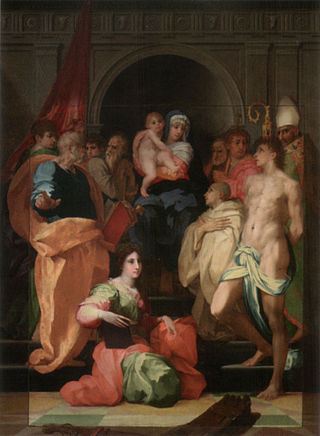
The Spedalingo Altarpiece' or Ognissanti Altarpiece is a 1518 oil on panel painting by Rosso Fiorentino, now in the Uffizi in Florence, which acquired it in 1900. It was commissioned by Leonardo Buonafede, "spedalingo" of the Hospital of Santa Maria Nuova in Florence. The contract was dated 30 January 1518. The painting was intended for the St John the Baptist chapel in Ognissanti according to the will of Francesca de Ripoi, a Catalan widow.

The Carmignano Visitation is a c.1528-1530 oil on panel painting of the Visitation by Pontormo, now in the propositura dei Santi Michele e Francesco in Carmignano.

The Risen Christ in Glory is a 1528–1530 oil on panel painting by Rosso Fiorentino, now in the Diocesan Museum in the Città di Castello. It shows the risen Christ with Mary Magdalene, the Virgin Mary, Saint Anne and Mary of Egypt.

Nativity of Saint John the Baptist is a 1526 oil on panel desco da parto painting by Pontormo, now in the Uffizi, where it has been since at least 1704. There is a copy in the Fogg Art Museum. Its status as an autograph work is accepted by most art critics, but was disputed by Philippe Costamagna.

The Dead Christ with Angels or Four Angels Lamenting the Dead Christ is an oil on panel painting by Rosso Fiorentino, executed c. 1525–1526, now in the Museum of Fine Arts in Boston.

Moses Defends Jethro's Daughters is an oil on canvas painting attributed to Italian artist Rosso Fiorentino, created c. 1523–1524, now held in the Uffizi in Florence, which acquired it in 1632. It depicts the Biblical episode when Moses defended the seven daughters of Jethro, who would be his father-in-law.

The Dei Altarpiece is an oil on panel painting by Rosso Fiorentino, commissioned in 1509 by the Dei family and completed in 1522. It is now in Florence's Galleria Palatina, whilst the Uffizi holds a preparatory drawing which may be the original idea for the work.

Cherub Playing a Lute or Musical Cherub is a 1521 oil on panel painting by Rosso Fiorentino, now in the Uffizi in Florence. It is signed "Rubeus Florentinus" and dated - though the date is unclear it probably reads 1521.

Portrait of a Young Man is an oil on wood painting by Rosso Fiorentino, executed c. 1517–1518, now in the Gemäldegalerie, Berlin.

Portrait of a Young Woman is a c. 1510 oil on canvas painting, usually attributed to Rosso Fiorentino, though Giovanni Larciani has also recently been suggested as its artist. It is now in the Uffizi in Florence. It is usually thought to be an early work by Rosso, produced before the frescos of the Chiostrino dei Voti at Santissima Annunziata, Florence, though its sharp style makes it hard to give a definite attribution to Rosso.

Adoration of the Magi is a c.1522-1523 oil on panel painting by Pontormo, produced for the antechamber of Giovan Maria Benitendi's palazzo in Florence and now in the Galleria Palatina in the same city.

Expulsion from Paradise or the Expulsion of Adam and Eve is an oil on panel painting by Pontormo, now in the Uffizi in Florence, whose Gabinetto Disegni e Stampe also has a preparatory drawing for it. Its dating is also uncertain and varies between c.1519 and c.1543, but is held to be c.1535 by the Uffizi.

Woman with a Basket of Spindles is an oil-on-panel painting, executed c. 1514–1515, now in the Uffizi in Florence. It is attributed to Pontormo or Andrea del Sarto. The work arrived in the Palazzo Pitti's gallery in 1773, as recorded in a note on the reverse, and in 1784 it was hanging in the Sala dell'Ermafrodito. It was last restored in 1996.

The Ten Thousand Martyrs is an oil on panel painting by Pontormo, executed c. 1529–1530, produced for the monks of Florence's Spedale degli Innocenti and now in the city's Galleria Palatina. It shows the martyrdom of the eponymous martyrs alongside Saint Maurice. A copy of the left hand side of the work in the Uffizi is attributed to a young Bronzino.

Scene from Hospital Life is a monochrome fresco fragment by Pontormo, executed c. 1514, originally in Florence's Ospedale di San Matteo, from which it was removed in the 18th century when that building was converted into a museum. It is now in the city's Galleria dell'Accademia.

Madonna and Child with the Infant Saint John the Baptist is an oil on panel painting by Pontormo, now in the Uffizi, whose Gabinetto dei Disegni e delle Stampe also houses a preparatory drawing for the work. The two theories on its dating are 1534-1536 and Antonio Natali's theory of 1529–1530.

Madonna of the Book is a c.1540–1545 oil on panel painting by Pontormo, heavily influenced by Michelangelo and now in a private collection. It may be the work described in Lives of the Artists as a "canvas of Our Lady" found among drawings, cartoons and terracotta models in the painter's home after his death and which was then given to Piero Salviati by the painter's heirs.

Holy Family with the Infant Saint John the Baptist is a c.1522-1523 oil on panel painting by Pontormo, produced early in his career. It now hangs in the Hermitage Museum, which acquired it with countess E. I. Mordvinova's collection. A preparatory drawing survives in the Uffizi's Gabinetto dei Disegni e delle Stampe.

Saint Anthony Abbot is an oil on panel painting by Pontormo, now in the Uffizi in Florence.

Portrait of Maria Salviati is an oil on panel painting attributed to Pontormo, executed c. 1543–1544, in the Uffizi, Florence.






















